Whereas it is easy to include "Hacienda Tokens" and "Mining Tokens" on a Coinage website and, as Pradeau remarked, "Municipal Tokens" were always a response to the lack of fractional coinage, listing “Other Tokens” on a website dedicated to Coinage will always be a difficult decision. In general, it is expected that the token
(a) was used in trade, and
(b) had a specified value, preferably as a unit of currency.
The following pages, classified (and occasionally sub-classified) by state, include
(a) tokens issued by some businesses, either given to employees in the same manner as "Hacienda Tokens" or "Mining Tokens", or to customers,
(b) tokens issued by shops, usually given to customers as a substitute for small change or part of a 'loyalty scheme',
(c) token issued by hotels, cantinas, bars and saloons. These were most often to encourage trade, though it is claimed that some were used for deposits (as with Licores, S. A.) or to reward bar-girls. Most of these come from towns in Baja California, Sonora, Chihuahua, Coahuila, Nuevo León and Tamaulipas on the US border with the ones dating to Prohibition arousing the most interest.
(d) ancient transport tokens, usually good for a journey, such as Camioneros de Jalisco. More modern versions have been ignored.
(c) and (d) are included because they have been given an imprimatur by catalogues such as Grove's Tokens of Mexico.
The following pages do not include
(d) tokens for amusement arcades
(e) tokens for vending machines and car washes, and
(f) fantasies, etc.
even when included in Grove.
We have also listed a few tokens celebrating events, such as Porfirio Díaz' visit to Toluca in 1897 or the arrival of the railway at San Felipe, akin to proclamation medals.


the patio of the Washington Hotel Aguascalientes in the 1890
This hotel was already functioning by 1879. At the end of the nineteenth century it was owned by Domingo Velasco, who between 1894 and 1897 bought nearby land to expand it and by 1899 had in the "first courtyard hallway, two living rooms, twelve rooms, two dining rooms, a kitchen and a small annexed patio"{footnote}{/footnote}. In the second courtyard there were "ten rooms and a large room with six small rooms for toilets," and on calle Palmira ( now Antonio Acevedo Escobedo), had "ten rooms and a hallway for the street." In 1914 it hosted delegates to the Aguascalientes Convention.
Today, all that remains is a section of its façade, in the Plaza Fundadores.

Obverse: WASHINGTON HOTEL / AGUASCALIENTES / D. VELASCO
Reverse: 10
This was made by L. H. Moise, S. F.

Grove 1671
Obverse: WASHINGTON HOTEL / AGUASCALIENTES / D. VELASCO
Reverse: 25
25mm.


Grove 1973
Obverse: CAMIONEROS / DE AGUASCALIENTES
Reverse: BUENO POR / UN PASAJE
20 mm.

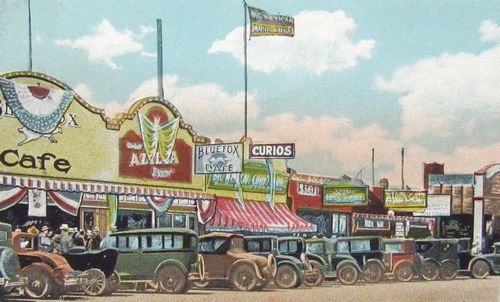
The Aloha Cafe in 1930
The Aloha Café was located on Avenida Revolución. It was first opened e during Prohibition in 1928 by Fernando ‘Frank’ Blanco Cota. He had previously lost The Anchor Cafe in a 1927 fire. Both catered to the US Navy crowd. Cota was born in Ensenada but attended school and lived above the border in San Diego. His place was connected with amateur boxing, promoting bouts between Tijuanans and Americans held in the Aloha Cafe Arena.
The U.S. federal prohibition of alcohol ended in 1933, with California following suit on 8 April. A mere two months later, 150 businesses in Tijuana had closed, including 60% of the bars. As a result. Cota regularly advertised the liquor and dancing of his place to San Diegans, beckoning them to experience the racy Honolulu Trio and their ‘latest hula thrills.’
In November 1938 half a block along Main Street burned down, including the Aloha Cafe. Frank Cota rebuilt and re-opened the bar in the early months of 1939 with neighbour Francesco ‘Frank’ Maggiora{footnote}The Maggiora family came from the Refrancore wine country in Piedmont Italy. Angelo Della Maggiora and Giovanni ‘John’ Maggiora settled in San Diego, and for years operated a bar before the Volstead Act was passed. After the prohibition of alcohol in America, many immigrant families that had for generations been winemakers in Italy migrated south of the border. The Maggioras, Cardinis, Cardinales and Mirabiles were part of a large group of Italian immigrants that settled in Tijuana, profiting from the big Dry Law surge in business.{/footnote}. Together they boasted their establishment was the ‘liveliest nite spot in town,’ open all night.
In the 1940s, The Aloha promoted tequila drinks a-plenty and live entertainment, with floor shows every half-hour by a cast of regular dancers. Many rock bands, including Carlos Santana, played there. It became a disco in the 1970s, a strip club in the 1980s, and closed in 2011, after a fire.
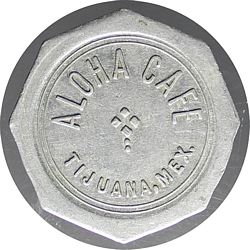
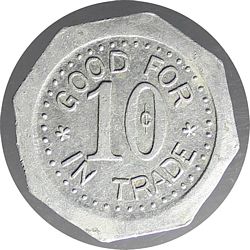
Obverse: ALOHA CAFE / TIJUANA, MEX.
Reverse: GOOD FOR / 10¢ / IN TRADE
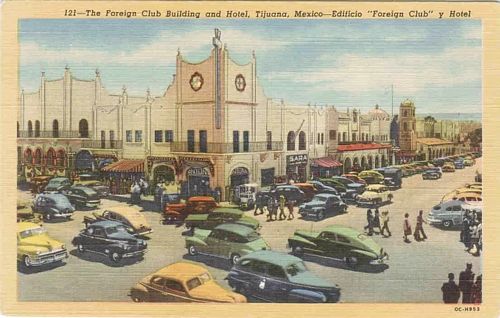
The Foreign Club was Tijuana’s most popular casino and nightclub for many years until eclipsed by the grandeur of Agua Caliente. The compound was located on the corner of calle Tercera and avenida Revolución.
In the early 1900s, progressives were shutting down gambling and aiming for the prohibition of liquor. California’s ‘Red Light Abatement Act of 1913’ pretty much shut down prostitution in San Diego’s Stingaree District. So three American investors, Marvin Allen, Frank Beyer and Carl Withington, formed their ABW Syndicate (Owl Café, Monte Carlo, Tivoli Bar, Foreign Club, Jockey Club) to fully take advantage of Baja California’s licensing of gambling casinos, cabarets, saloons and prostitution. Wirt G Bowman joined the group on Withington’s death, and later invested in building the Agua Caliente casino and resort. A silent partner who afforded them some protections was Colonel Aberlardo Rodriguez, former president of México and later governor of Sonora. After a fire, the resort was completely redesigned and rebuilt by San Diego architect Frank W Stevenson.
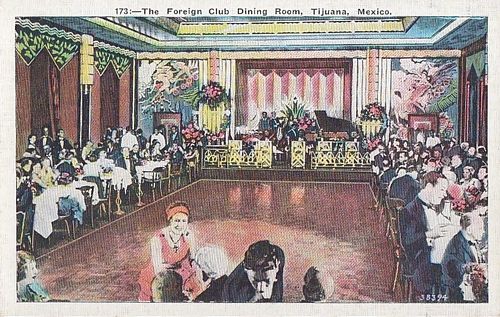 The Foreign Club Cafe de Luxe was the place to dine and dance after a heavy night of gambling — cards, roulette, slots. Full meals were $1 to $1.50. A la carte you could get filet mignon with mushroom sauce for one dollar. Caviar, seventy-five cents. Breakfast served all day – their rhum omelette was a pricey one dollar. As for native Mexican food, they offered homemade chicken tamales, stuffed peppers or turkey enchiladas, two for fifty cents. Local wines were one dollar a bottle. The Foreign Club catered exclusively to affluent Anglo-American customers who had come down to ‘do Tijuana.’ Few Mexicanos were employed there, and blacks were not allowed admittance.
The Foreign Club Cafe de Luxe was the place to dine and dance after a heavy night of gambling — cards, roulette, slots. Full meals were $1 to $1.50. A la carte you could get filet mignon with mushroom sauce for one dollar. Caviar, seventy-five cents. Breakfast served all day – their rhum omelette was a pricey one dollar. As for native Mexican food, they offered homemade chicken tamales, stuffed peppers or turkey enchiladas, two for fifty cents. Local wines were one dollar a bottle. The Foreign Club catered exclusively to affluent Anglo-American customers who had come down to ‘do Tijuana.’ Few Mexicanos were employed there, and blacks were not allowed admittance.
Entertainment, of course, was provided — orchestras, floorshows and dancing. In 1932-33 the pre-eminent dancers to perform at The Foreign Club were Spaniard Eduardo Cansino and daughter Margarita. Their provocative dances Eduardo choreographed got the fourteen year-old noticed by Hollywood types visiting Tijuana. Margarita soon got studio contracts and took her mother’s maiden name — to become Rita Hayworth.
Mexican President Cardenas’ ban on gambling effectively shut down entire resorts like the Foreign Club and Agua Caliente casinos. The Mexican government took possession, converting Agua Caliente into a girls’ school. The Foreign Club burned down in 1935.
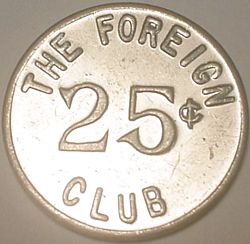

Obverse: THE FOREIGN / 25¢ / CLUB
Reverse: THE FOREIGN / 25¢ / CLUB
Obverse: THE FOREIGN / $1.00 / CLUB
Reverse: THE FOREIGN / $1.00 / CLUB
Obverse: THE / FOREIGN / CLUB
Reverse: GOOD FOR / 15¢ / IN TRADE
23mm. brass
Licores was a chain of liquor stores owned by the brothers Wulfrano and Wilfrido Ruiz.
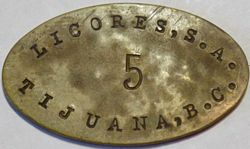

Grove 1700
Observe: LICORES. S. A. / 5 / TIJUANA. B. C.
Reverse: SUCURSALES / ENSENADA / MEXICALI
oval 20 x 35 mm.
This companies produced various series of round tokens. The first has incused denominations.
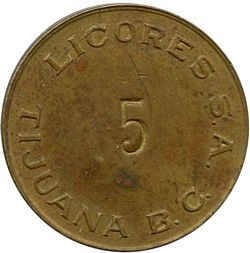
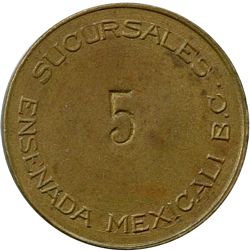
Grove 1701
Observe: LICORES. S. A. / 5 / TIJUANA. B. C.
Reverse: SUCURSALES / 5 / ENSENADA MEXICALI B. C.
24 mm.
Grove 1702
Observe: LICORES. S. A. / 10 / TIJUANA. B. C.
Reverse: SUCURSALES / 10 / ENSENADA MEXICALI B. C.
24 mm.
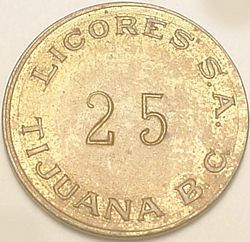
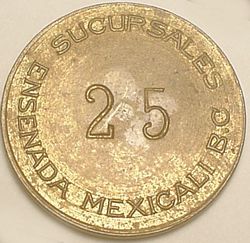
Grove 1704
Observe: LICORES. S. A. / 25 / TIJUANA. B. C.
Reverse: SUCURSALES / 25 / ENSENADA MEXICALI B. C. (incused 10)
22.5 mm.
A second series had raised denominations.
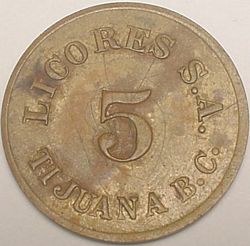
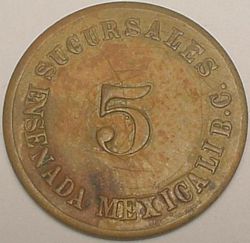
Observe: LICORES. S. A. / 5 / TIJUANA. B. C.
Reverse: SUCURSALES / 5 / ENSENADA MEXICALI B. C.
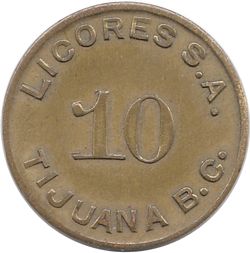
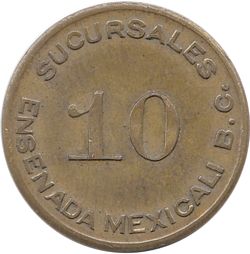
Grove 1703
Observe: LICORES. S. A. / 10 / TIJUANA. B. C.
Reverse: SUCURSALES / 10 / ENSENADA MEXICALI B. C.
22 mm.
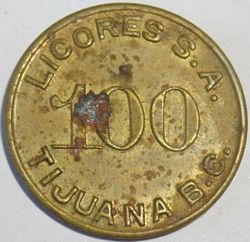
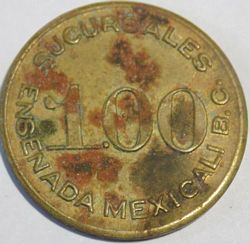
Grove 1706
Observe: LICORES. S. A. / 100 / TIJUANA. B. C.
Reverse: SUCURSALES / 100 / ENSENADA MEXICALI B. C.
22.5 mm.
Another series have a string of dots around the edge.

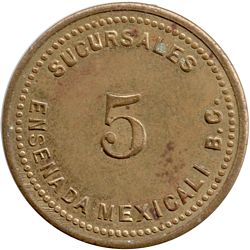
Observe: LICORES. S. A. / 5 / TIJUANA. B. C.
Reverse: SUCURSALES / 5 / ENSENADA MEXICALI B. C.
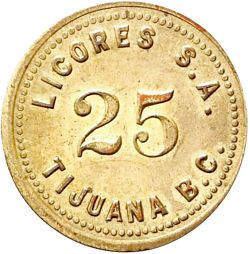
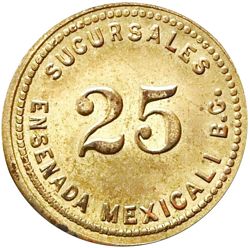
Grove 1705
Observe: LICORES. S. A. / 25 / TIJUANA. B. C.
Reverse: SUCURSALES / 25 / ENSENADA MEXICALI B. C.
23 mm.

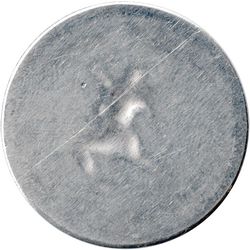
Obverse: SALON VENUS / TIJUANA, MEX.
An Anillo restrike of one side of the original token.
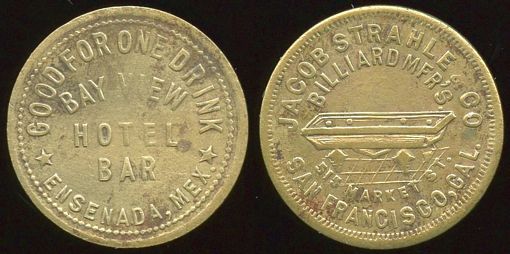
Obverse: GOOD FOR ONE DRINK / BAY VIEW / HOTEL / BAR / ENSENADA, MEX.
Reverse: JACOB STRAHLE & CO / BILLIARD MFR'S / 515 MARKET ST. / SAN FRANCISCO, CAL
24 mm. brass
During the early 1880s there were several billiard table manufacturers in the San Francisco area of California. By the mid 1880s the firm of Jacob Strahle and Company began distributing tokens which advertised its billiard tables on the reverse and had the name of the issuing saloon keeper or merchant on the obverse. Undoubtedly this was done to meet the competition of J. M. Brunswick and Balke Company, which had started issuing its tokens in California during the early 1880s.
The California gold rush brought twenty year old Jacob Strahle to San Francisco in search of a living. Bom on 22 August 1831 in Germany, he arrived in California in 1851 and remained there until his death on 24 November 1909. Little is known about his early life, except that in 1852 he went into business as a billiard table maker in San Francisco. In 1871 Ferdinand de St. Germaine was brought into the firm by Jacob Strahle, who apparently sold the firm or turned it over to St. Germain about three years later. After taking over the firm, St. Germain continued its operation under the Jacob Strahle name until his death in about 1890.
After being located at 533 Market Street for about ten years, the Strahle firm moved to 515 Market Street about 1883, and the tokens show this address. Therefore, they must date from 1883 and thereafter.
All Jacob Strahle tokens were struck in either brass or white metal {footnote}For a history of this company and the tokens that it promoted, see Richard Magnuson, “Jacob Strahle, Billiard Table Manufacturer” in TAMS Journal, vol. 32, Number 1, February 1992{/footnote}. The company produced tokens for three clients in Ensenada, the Bay View Hote, Blundon & Bennett and the Reform Saloon.
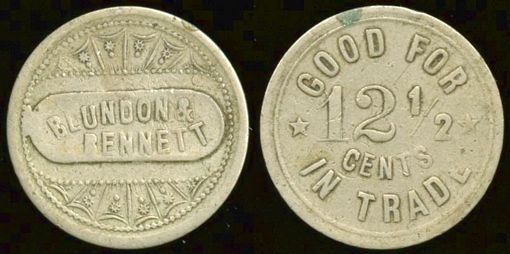
Obverse: BLUNDON & / BENNETT
Reverse: GOOD FOR / 12½ / CENTS / IN TRADE
Blundon & Bennett were dealers in general merchandise, with two establishments: one in Ensenada and the second in San Quentin, California.
BLUNDEN & BENNETT, DEALERS IN GENERAL MERCHANDISE.
It is safe to say that there are few more enterprising young business men iu Lower California than Messrs. Blundon & Bennett, wholesale and retail dealers in General Merchandise, Wines, Liquors, Cigars, Tobacco, etc. Mr. J. W. Blundon, the senior member of the firm, and by profession an architect, has had, perhaps, as eventful a career as any man of his years in tbe State. He was born In Washington, D. C, in and was educated at Georgetown College.
Upon attaining his majority he entered the United States Army, from which he was discharged in 1883 with the rank of first sergeant. One of the mott exciting episodes of his military career was the Meeka Indian outbreak. in Colorado, during which time he was wounded. He was then, for a time, in the employ of the Northern Pacific Railroad as engineer, but came that same year (1883) to San Francisco. In that same year, also, he was married to Miss Carrie Shoenman, the first female compositor to enter Ensenada, and the first to set type on the Voice of the Frontier, a weekly paper published at that place.
Mr. Blundon arrived at Ensenada in 1896, in the employ of the International Company, as architect and superintendent of construction of their large hotel and other work, which position he resigned to engage in his present business.
His partner, Mr. L. B. Bennett, is a native of Louisville. Ky., and. by profession, a lawyer. He is a graduate of the State University Law School of Kentucky, and has practiced bis profession in Louisville and several Western towns.
Messrs. Blundon & Bennett now have two well-stocked, prosperous establishments: one in Ensenada, on the corner of First and Rinz streets; and one in San Quentin, on the coiner of Thirteenth and Empressa streets. In conclusion, it is sale to say that few business men in Lower California will commence the New Year with any brighter prospects than Messrs. Blundon & Bennett{footnote}San Francisco Examiner, 1 January 1888{/footnote}.
This was a general store for Chinese imigrants, which issued tokens from 1910 to 1920.
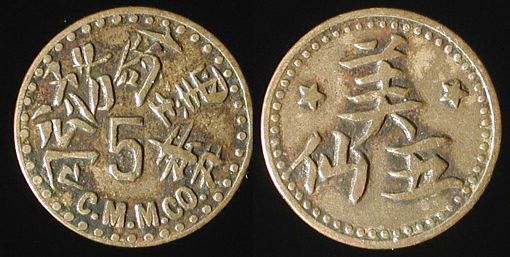
Obverse: (司 公 務 商 墨 [ ] / 5 / C.M.M. CO.
Reverse: 美 / 仙 五
Obverse: (司 公 務 商 墨 [ ] / 10 / C.M.M. CO.
Reverse: (Chinese characters)
Obverse: (司 公 務 商 墨 [ ] / 25 / C.M.M. CO.
Reverse: (Chinese characters)
30mm. brass
The Chinese is
司 公 務 商 墨 [ ]
si-gung-mouh-seung-mahk-wah (Company Mercantile Mex. Chinese)
美 仙 五
meih sin ngh (U.S. cents five)
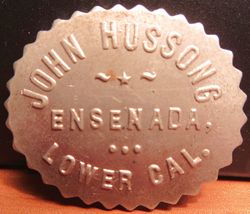
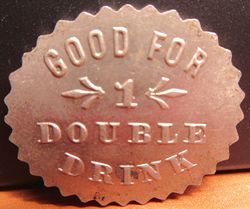
Hussong's founder, Johann Hussong, was born in Forhsam, Germany in 1863. Johann emigrated to the United States in 1888 and changed his name to John. In 1889, the discovery of gold south of the border lured John to Ensenada. John made a living hunting and trading supplies up and down the Baja coast. In June 1891, while on a trading expedition to El Arco, John's carriage flipped over, and his companion, Newt House, fractured his leg. John brought Newt to recuperate at Meiggs' Bar, which back then, was Ensenada's only watering hole. Two days after John and Newt arrived at the bar, Meiggs attacked his wife with an axe. When Meiggs was sent to jail, his wife fled to California. When he got out of jail, Meiggs went in search of his wife, and asked John to mind the bar until he returned. Neither Meiggs nor his wife ever returned. After operating the bar for nearly a year, John purchased and remodeled the building across the street, which was a Southern Lane stage coach stop that bookended the route between Los Angeles and Ensenada. In 1892 he obtained an alcohol license and started operating the John Hussong Bar.
Hussong's is reputedly the place where the Margarita was created in October, 1941 by bartender Carlos Orozco. He concocted a mixture of equal parts tequila, damiana (Cointreau is used now) and lime, served over ice in a salt-rimmed glass for Margarita Henkel, daughter of the German Ambassador to Mexico.
Obverse: JOHN HUSSONG / ENSENADA / LOWER CAL.
Reverse: GOOD FOR / 1 / DOUBLE / DRINK
Grove 1722
Obverse: MARIANO MA / M / MEXICALI, B. C.
Reverse: GOOD FOR / 50¢ / IN TRADE
30mm. bronze
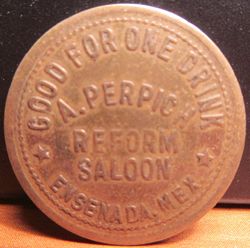
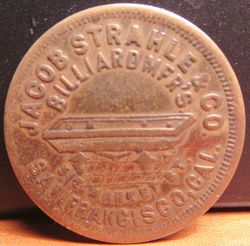
Obverse: GOOD FOR ONE DRINK / A. PERPICH / REFORM / SALOON / ENSENADA, MEX.
Reverse: JACOB STRAHLE & CO / BILLIARD MFR'S / 515 MARKET ST. / SAN FRANCISCO, CAL
24mm. brass
Obverse: SALON ORIENTAL / 1928 / ENSENADA
Reverse: GOOD FOR / 10¢ / IN TRADE
24mm. brass
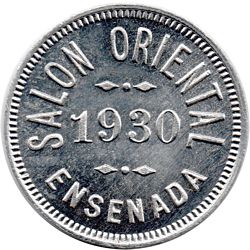
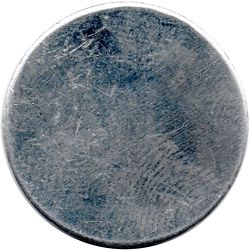
Obverse: SALON ORIENTAL / 1930 / ENSENADA
24mm. aluminum
These are Anillo restrikes so we only have one face.
<
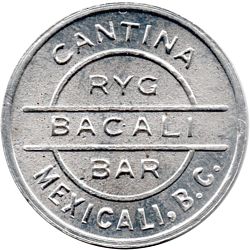

Obverse: CANTINA / RYC / BACALI / BAR
Reverse: MEXICALI, B.C.
An Anillo restrike.

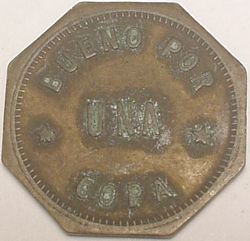
Obverse: HOLLMANN / MEXICALI / B. C. MEX.
Reverse: BUENO POR / UNA / COPA
These were made by L. A. Rubber Stamp Co.
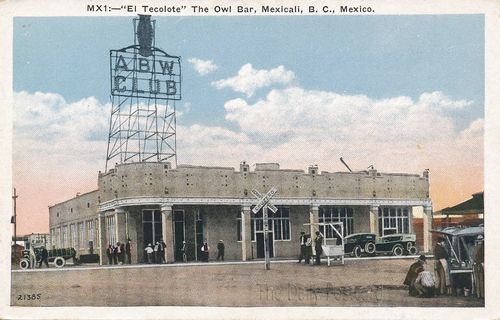
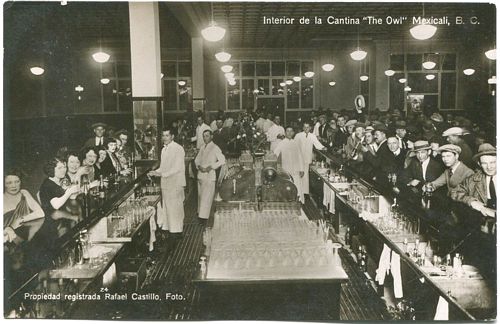
Various establishments catering to vice and other sorts of tourists along the Mexican border offered tokens to their clients. Such tokens were generally made of brass, bronze, aluminum, copper or nickel and were good in trade or merchandise for 5c, 10c, 25c, 50c and one dollar (the dollar was used more often than the peso).
One such establishment was the famous Owl Bar (El Tecolote) in Mexicali, Baja California. Three cabaret owners and operators who were driven out of the Bakersfield, California area by a reform movement went to Mexicali in 1913 and founded the bar. As their names were Marvin Allen, Frank “Booze” Byers, and Carl Withington, they called their company the A.B.W. Corporation.
The Owl Bar featured a casino, dance hall, a brothel, and of course lots of alcohol. At its height, more than sixty girls appeared nightly in the dance hall and among the tables. A gallery, used exclusively for ‘slumming parties’, was rarely empty of tourists from the American side of the border. An advertisement for Mexicali’s nightlife from 1922 stated, “The Owl is of special interest to those who desire to go slumming. A private entrance for private parties is afforded and booths are arranged along the side of the dance floor, which give seclusion to those who merely wish to look in.”
Not surprisingly, many of the most interesting stories relate to the brothel and its 104 rooms. According to Andrew Grant Wood, in his On the Border: Society and Culture between the United States and Mexico{footnote}Andrew Grant Wood (ed.), On the Border: Society and Culture between the United States and Mexico, Rowman & Littlefield, Lanham, MD., 2004{/footnote} the prostitutes represented a variety of ethnicities and races, but the customers were segregated by race. There was a section for white customers and a separate section for non-white customers. It would also appear that once the prostitutes were there, they were not free to leave. The Owl was leveled by an earthquake in 1915 and burnt down a couple of times and a number of U.S. newspapers covered the story of the 1920 fire that sent scantily-clad prostitutes fleeing from the building. The club also burnt down on 30 May 1934{footnote}The San Bernardino County Sun, 31 May 1934{/footnote}.
Although regularly censored, the A.B.W. casinos in Tijuana, Mexicali, Algodones and Tampico avoided permanent closure because of the powerful connections they had forged with the Calles and Obregón administrations. In 1922 an $80,000 donation to the governor of Baja California, General Abelardo Rodríguez, allowed for an extension of The Owl’s gambling permits, under the new name, The A.B.W. Club. However, on 20 July 1935, by orders of the more austere President, General Lazaro Cardenas, the operation was closed completely.
The Owl Bar issued tokens produced by the L.A. Rubber Stamp Company, of Los Angeles, California.

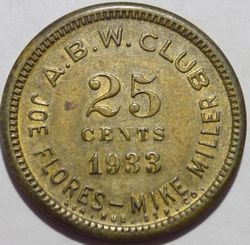
Grove 1265
Obverse: A. B. W. CLUB / MEXICALI, MEXICO
Reverse: A. B. W. CLUB / 25 / CENTS / 1933/ JOE FLORES - MIKE MILLER
24mm. brass
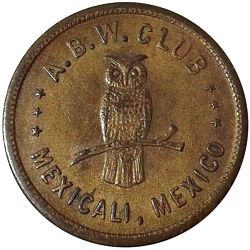
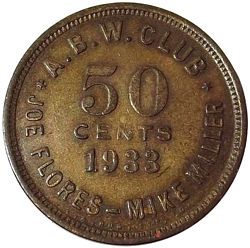
Grove 1266
Obverse: A. B. W. CLUB / MEXICALI, MEXICO
Reverse: A. B. W. CLUB / 50 / CENTS / 1933/ JOE FLORES - MIKE MILLER
30mm. brass

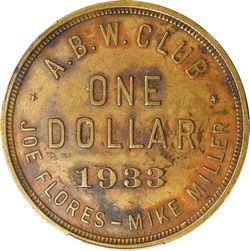
(Stack’s Bowers Auction, 16 May 2023, lot 70687)
Grove 1267
Obverse: A. B. W. CLUB / MEXICALI, MEXICO
Reverse: A. B. W. CLUB / ONE / DOLLAR / 1933/ JOE FLORES - MIKE MILLER
24mm. brass
In 1967 Anillo Industries, Inc., of Orange, California, bought at auction, 3,492 token dies belonging to the L. A. Rubber Stamp Co., which had gone out of business. Anillo attempted to go into the token striking business and, using the token dies, struck twenty five sets of aluminum manufacturer’s sample tokens. The reverses are blank and are flat since they were designed to be mounted in salesmen’s sample catalogs. It is believed that twenty-two complete sets and three partial sets of these tokens exist, including examples of the A. B. W. Club.



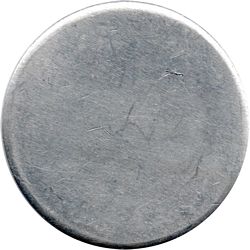
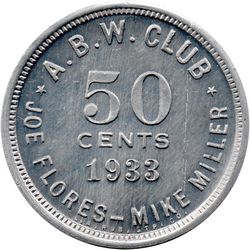

Those who have lost the will to live can note that there are two different die varieties of the 50c restrike. In Die #1 the "5" and "0" are fairly close together. The "T" in "CENTS" is centered under the "0" of "50". "L.A. RUB. STP. CO." is lightly stamped and the "RU" of "RUB." is under the bar between 'FLORES" and "MIKE". In die #2 the "5" and "0" are farther apart than on Die #1. The vertical leg of the "T" in "CENTS" is offset to the left and points up the inner edge of the left part of the "0" in "50". "L.A. RUB. STP. CO." is heavily stamped and the "UB" of "RUB." is under the bar between 'FLORES" and "MIKE". There are other variations in letter spacing between Die #1 & Die #2, but the above are the easiest ones to spot.
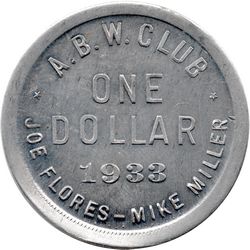


Kondo Masaharu was a pioneer of the West Coast fishing industry. He was born in Kyoto, Japan in 1877 and attended the Tokyo Tekoku Daigaku (Tokyo Imperial University) where he majored in agriculture. After graduation Kondo began to teach at the Imperial Fisheries Institute of Tokyo where he was eventually appointed to the school’s Board of Commissioners. While serving in this capacity, he was appointed to undertake a tour of the world to investigate the state of fishing technology outside Japan. The first country on his itinerary was the United States.
Shortly after his arrival in the United States in 1908, Kondo visited the Los Angeles-San Pedro area to observe at first hand the activities of the fishing fleet. It was through acquaintances in Los Angeles that he met and became involved with Aurelio Sandoval, a resident of Los Angeles, who was head of the International Fisheries Company which held an exclusive concession from the Díaz government to the fisheries of Baja California. Sandoval wanted to develop the Mexican fisheries but lacked the necessary capital and so approached Kondo on the possibility of large scale Japanese financing.
The Mexican Revolution of 1910 notwithstanding, Sandoval, with the assistance of French investors, opened a small lobster cannery in Baja California on Santa Margarita Island in Magdalena Bay. Then, in 1912 Kondo returned to the United States with the necessary financial backing and obtained concessions to fish on the west coast of Baja California from both Sandoval and the Madero government. As part of the agreement with Sandoval, Kondo assumed ownership of the canning operation at Magdalena Bay.
From 1920 to 1923 the abalone and tuna operations prospered to such a degree that Kondo once again decided to return to Japan to seek financing for two additional projects. The major thrust of this trip was to raise money to build a cannery at Turtle Bay which would allow the tuna catch to be processed in Mexico, and then shipped directly to the markets in Japan and the United States. With assurances of financial support, Kondo and Hisahira formed the Taiyo Sangyo Gaisha (Southern Commercial Company) in the spring of 1924. The new company was later incorporated in California in 1927 as the Oceans Industry Company.
At the time the cannery was started, there were approximately fifty Mexican labourers also working for the Taiyo Sangyo Gaisha who lived on the site with their families. It is estimated that there were approximately three hundred and fifty people living at the bay in 1928.
The completion of the cannery brought a kind of economic prosperity to Turtle Bay that had been unknown up to that time. At first, as Kondo’s men began to train Mexican workers to operate the cannery, they found it was easier to pay the Mexicans in coins minted by the L. A. Rubber Stamp Co., which were redeemable at a company run store; later they were paid in dollars{footnote}Don Estes, “Kondo Masaharu And The Best Of All Fisherman” in The Journal of San Diego History, Summer 1977, Volume 23, Number 3{/footnote}.
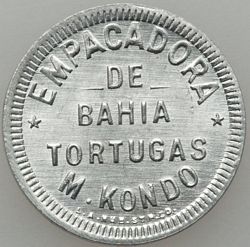
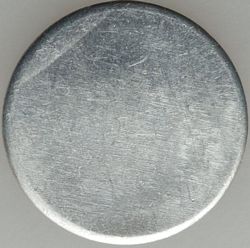
.
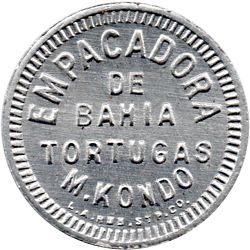
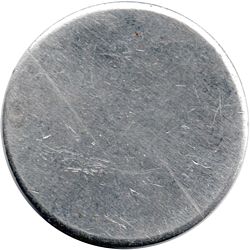
The Casino Campechano of Lorenzo Betancourt opened in December 1887{footnote}Periódico Oficial, Año V, Núm. 482, 13 Decemberr 1887{/footnote}.
Grove 1232
Obverse: CASINO CAMPECHANO / CAMPECHE
Reverse: 5
28mm. black plastic